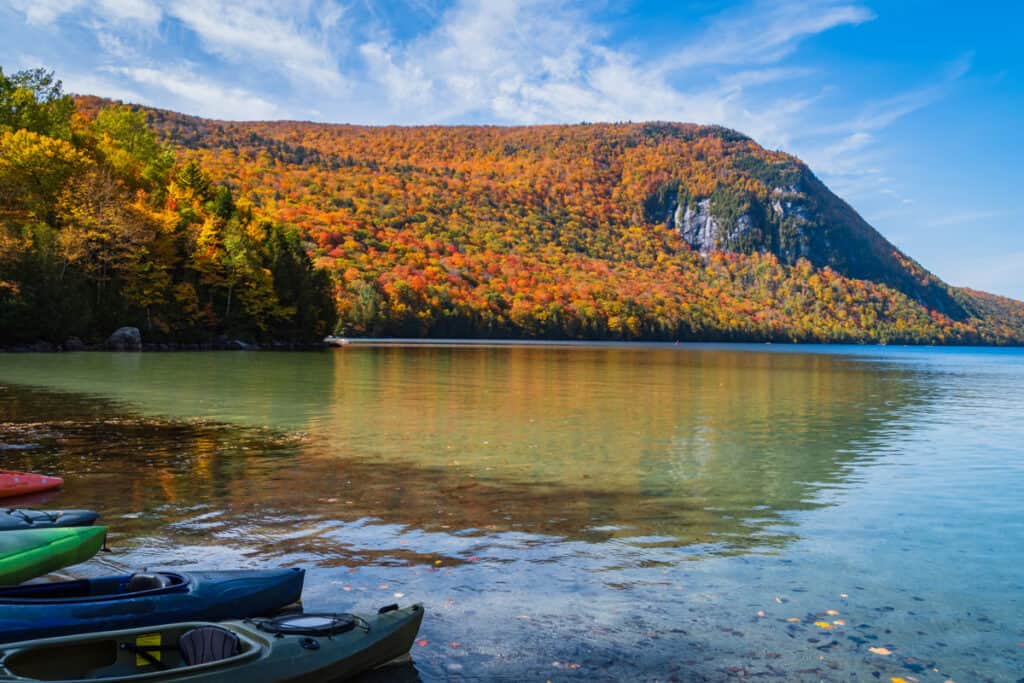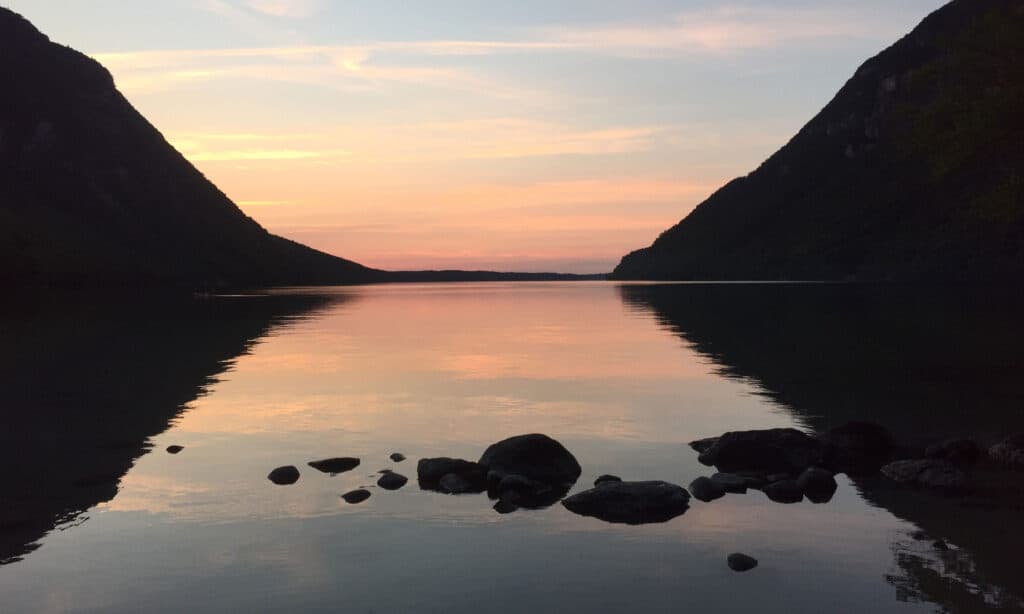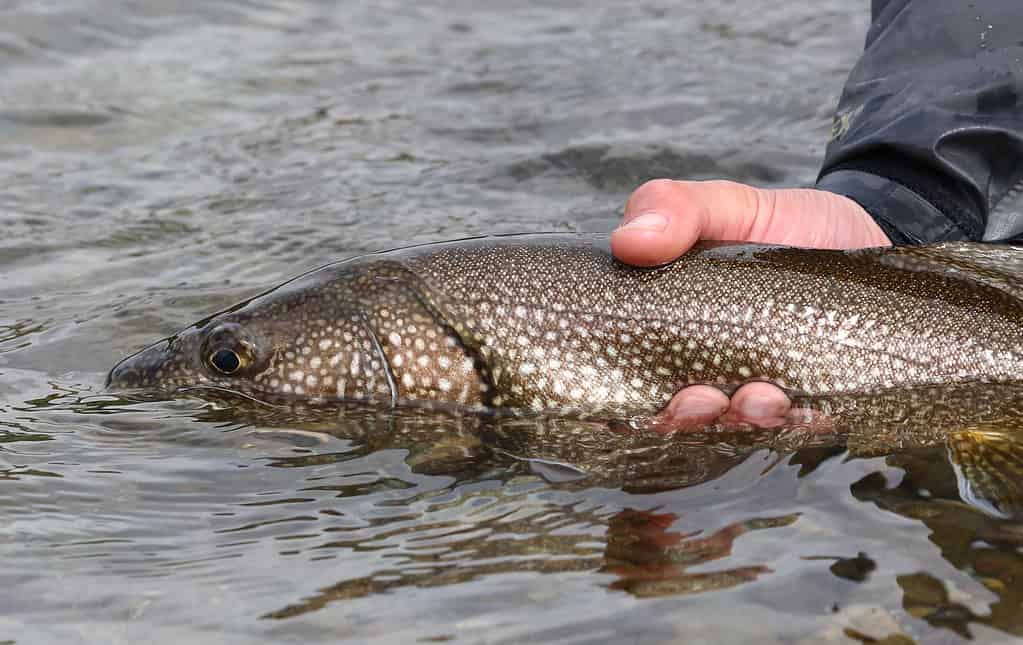Lake Willoughby is located in Vermont in the United States. It’s one mile wide and reaches a depth of 328 feet, which makes it the deepest lake entirely in Vermont. It’s known for its depth, which makes it one of the area’s last lakes to freeze over, and its top-of-the-range trout fishing. Let’s discover Lake Willoughby, its fishing, size, depth, and more, including its surrounding hiking trails and camping facilities.
Location
Northeastern Vermont’s Lake Willoughby is situated in Willoughby State Forest’s north. Highway 5A runs alongside its west flank. Drive south for 40 minutes, and you’ll reach the Canadian border.
The lake’s southern end is encased by lush green forest. Two beaches lie on its shores with swimming and boat access. On the eastern coast lies Westmore town and White Caps campground, a beautiful beach fills the southern tip. Opposite, on the northern tip, lies another campground called Will-o-wood.

Willoughby State Forest wraps around the lake’s southern shore.
©iStock.com/vermontalm
History
Carved out by glaciers, Lake Willoughby’s natural resources lay unexploited until New Englanders settled nearby and used the river and falls to power machinery. Barton, which is close by, was home to much industrial activity, but the steep mountains surrounding the lake made it difficult to access.
Settlers created homesteads near Lake Willoughby, and a lumber mill was built near the south shore. In the century’s last decade, wealthy holidaymakers spent time in Vermont’s lake resorts, but once rail became most accessible in the 1900s, tourists took themselves to ocean destinations instead.
Of course, there’s a legendary Lake Willoughby monster story, and not just one!
In 1868 reports emerged that 12-year-old Stephen Edmonds had killed a “great water snake” with a sickle. Reports said the two halves rejoined measured 23 feet in length.
Another local legend says an underground passageway exists between Lake Willoughby and neighboring Crystal Lake. The rumor is that a team of horses fell through ice and month later, turned up in Crystal Lake. This legend was given a boost in 1950 when divers recovering a drowned man’s body discovered a huge hole at the lake’s bottom allegedly full of 8 feet long eels.
And finally, in 1986, Audrey Basse, sitting near Wheeler’s camp beach, spotted an “unknown creature: long with two or three humps” in the lake. By the time she’d retrieved binoculars, it had vanished.
Size
Lake Willoughby is a glacial slash between two rocky mountains. Visitors say it looks like a Norwegian fjord.
Its surface measures 1,687 acres, and it’s comprised of five miles in length but just one mile wide, so it’s not the largest lake, but its clear water and mountainous scenery make up for it. Plus, its remote terrain means fewer visitors if you prefer solitude.

Lake Willoughby is Vermont’s deepest lake. Its depths reach 328 feet.
©iStock.com/Tracy Lavallee
Depth
This is the deepest lake in Vermont. Its glacier-carved grooves spiral to 328 feet deep, and because it’s so deep, it’s one of the final freeze-overs in Vermont. The average depth is 185 feet.
However, Lake Willoughby is a puddle compared to the U.S.’s deepest lake. The deepest lake is 1,949 feet deep, Crater Lake in southern Oregon. An erupting volcano formed that lake, blasting out rock 7,700 years ago, then rain and snowmelt filled it up.
Water Level
Lake Willoughby’s water levels vary according to the season, but because it’s the deepest lake in Vermont, it never dries up. Its great depth means its water level is stable, with only a few feet difference throughout the year.
Underwater springs, rain, and snow melt fill the lake, so it’s a little higher during heavy rainfall or late spring when the ice melts.
Fishing
Lake Willoughby’s fishing is top of the range, and anglers particularly favor lake trout that grow to enormous sizes in its cold, clear water. Shawn Dutil holds the state trout record, hooking his 35.3 lbs whopper from Lake Willoughby in 2003.
Here’s a list of Lake Willoughby’s most commonly caught fish:
- Rainbow trout
- Yellow perch
- Landlocked Atlantic salmon
- Longnose sucker
- Lake chub
- Round whitefish
- Walleye
- Rock bass

Heavyweight lake trout attract anglers to Lake Willoughby.
©Iryna Harry/Shutterstock.com
Geology
We know that glaciers carved Lake Willoughby from the ground 10,000 years ago, but what else is there to know?
The ice flow cut across Lake Willoughby’s granodiorite and metamorphic rocks, creating two large mountains on either side, now called Mount Pisgah and Mount Hor. It’s unique and a big draw for geology enthusiasts, photographers, and Instagrammers.
Boating
Steamboats traversed Lake Willoughby in the late 1880s when tourism was popular here, but now motor boats, sailing boats, canoes, and kayaks skim the surface instead. Note that jet skis or vessels with an inboard jet pump engine (PWCs) are not permitted here.
It’s possible to hire kayaks and canoes on the lake shore, and a boat ramp suitable for fishing boats is located on the northeast shore’s all-purpose Willoughby Lake Store. It’s called “Lake Willoughby Boat Access.” Nice and simple!
Lake Willoughby’s Activities
Hiking
Lake Willoughby is a popular fishing and beach destination, but its surrounding area is ripe for exciting hikes.
Willoughby State Forest on the lake’s southern end has plenty of trails for newbies and seasoned hikers. Tourists may spot chipmunks, raccoons, mink, deer, or foxes on the 2.1-mile easy Lake Willoughby Southshore Loop. Visitors say the best time to hike is during fall when the leaves change.
The surrounding mountains, created by glacial action, attract folks who love a good view. Mount Pisgah offers a 4.1-mile trail with 1,653 feet of elevation through the state forest and back. Pulpit Rock overlooking the lake is the place for an epic photograph.
On the other side, Mount Hor offers a different view of the lake, which is equally stunning as Mount Pisgah’s. The old Civilian Conservation Corps laid some of Mount Hor’s trails.
About 1.5 miles northeast of the lake, you’ll find Sentinel Rock State Park, with superb hiking trails and enough elevation to admire nearby Westmore town and the Green Mountains. It’s named for the vast glacial boulder sunset-viewing tourists like to sit on.

White-tailed deer live in Willoughby State Forest, grazing on shoots, buds, and grasses.
©iStock.com/Lightwriter1949
Biking
Lake Willoughby has a 100-mile track network through private land, but you’ll need a one-off membership. They’re available from the Kingdom Trail Association online store.
Bikers, horses, and hikers share the non-motorized trails. Keep dogs on a leash and stick to the path.

One hundred miles of biking,
horse
riding, and hiking trails surround Lake Willoughby.
©iStock.com/lzf
Camping
Camping at Lake Willoughby is not only beautiful but plentiful. It’s cold, and the lake freezes in winter, but in summer, it’s glorious. Try nearby Belview Campground, White Caps, Will-o-Wood, or Brighton State Park for tents and RVs (max 34 feet long at Belview).
Beaches
Water temperatures are pretty cold in Lake Willoughby, but the beaches are gorgeous. A 0.25-mile beach lies on the north shore of the lake and a second on the southern shore, but this is a nudist beach, so approach with this in mind!
Devil’s Rock, so called because it reflects a skull-like image on still water below, on Mount Pisgah’s side, is close to the southern beach. It’s a popular diving spot. On the eastern shore, natural waterslides ice over in winter, attracting adventurous ice climbers.
Swimming
Swimmers enjoy Lake Willoughby’s crystal-clear water in the summer months. With two beaches to choose from, it’s never busy here. In winter, the lake ices over but tends to thaw in late April; this means it is always chilly.
Bird Watching
Over 100 bird species are recorded around the lake and in Mount Pisgah and Hor’s surroundings. The mountainous fjord-like geology encourages cliff birds such as peregrine falcons and bald eagles.

Peregrine falcons nest on Mount Pisgah and Mount Tor’s craggy cliff faces.
©Harry Collins Photography/Shutterstock.com
In the forest, enthusiasts have spotted:
- Hummingbirds
- Thrushes
- Warblers
- Jays
- Finches
Herons, loons, and gulls are never too far off on the lake. Lake Willoughby is a bird spotter’s paradise.
Other Activities
In nearby Brownington’s Old Stone House Museum and historic village, visitors can learn about the first African American college graduate Alexander Lucius Twilight.
The photo featured at the top of this post is © NEKVT/Shutterstock.com
Thank you for reading! Have some feedback for us? Contact the AZ Animals editorial team.







